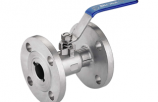Brief Introduction to Gate Valves
 secureluokai
secureluokai
 June 9, 2025
June 9, 2025

A gate valve is a type of valve used to stop the flow of media. When fully opened, the flow path is straight through, resulting in minimal pressure loss for the media. It is suitable for working conditions that do not require frequent opening and closing, and need to keep the gate fully open or closed. It is not suitable for flow regulation or throttling—if the gate is partially opened for high-velocity media, vibration may occur, damaging the sealing surfaces of the gate and seat; throttling operations can also cause erosion of the gate by the media.
In terms of structural design, the core difference between gate valves lies in the design of their sealing elements. According to the type of sealing element, they are mainly classified into wedge gate valves, parallel gate valves, parallel double-disc gate valves, wedge double-disc gate valves, etc. Among them, wedge gate valves and parallel gate valves are the most commonly used.
Introduction to Related Valve Types
Two related types of valves are briefly described below:
Check Valves
Function: Allow media to flow in only one direction and prevent backflow, operating automatically.
Principle: When flowing forward, the fluid pressure pushes open the disc; when backflow occurs, the fluid pressure and the disc’s own weight press the disc against the seat to cut off the reverse flow.
Types:
Swing Check Valves: The disc is connected via a hinge mechanism, resembling a door leaning against an inclined seat surface. The disc can be made of metal or inlaid with rubber and other materials. When fully opened, the pressure drop is minimal.
Lift Check Valves: The disc moves vertically along the valve body, similar in structure to globe valves. The flow passage is narrower, resulting in a larger pressure drop than swing check valves, with relatively more obvious restrictions on flow.
Control Valves
Function: Regulate parameters such as media pressure and flow in production to meet process requirements.
Principle: Achieve regulation by changing the flow area between the disc and the seat.
Classification:
Self-Driven Type: Driven by the media’s own power (e.g., pressure reducing valves, pressure stabilizing valves).
Externally Driven Type: Driven by external power (electricity, compressed air, hydraulic power) (e.g., electric control valves, pneumatic control valves).
Summary
Gate valves are primarily used for “cut-off” functions, with their structural types distinguished by sealing elements; check valves focus on unidirectional flow control; control valves are used for parameter regulation. These three types of valves each serve specific roles in industrial applications.





